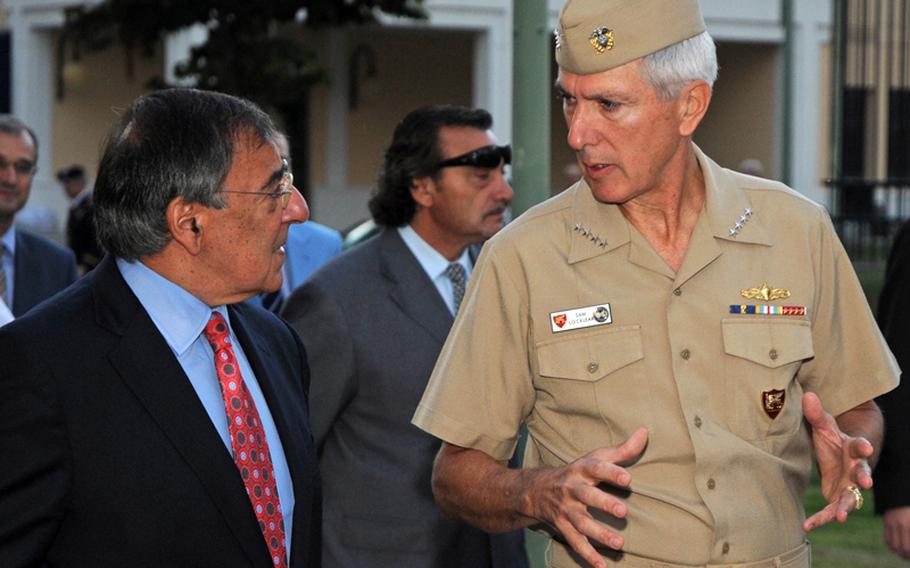
Adm. Samuel Locklear III, right, commander, U.S. Naval Forces Europe-Africa, and commander, Allied Joint Forces Command Naples, talks with Secretary of Defense Leon Panetta on the way to a briefing at Naval Support Activity Naples, Italy, in October, 2011. Locklear has been nominated to be the next commander of U.S. Pacific Command. (Daniel Viramontes/U.S. Navy)
SEOUL - The Obama administration’s nominee to lead U.S. Pacific Command has expressed his support for the planned consolidation of American troops in South Korea to bases south of Seoul by 2016, despite continuing opposition from senators considering his confirmation.
Adm. Samuel Locklear, as part of a 48-page response to policy questions posed to him by the Senate Armed Services Committee, wrote, “The movement of units and facilities to areas south of the Han River (which runs through Seoul) improves force protection and survivability, placing the majority of personnel and equipment outside of the tactical effective range of North Korean artillery.
“In addition, the move to central location outside of Seoul provides efficiencies, reduces costs, contributes to the political sustainability of our forward presence and improves military readiness on the Korean peninsula,” he wrote.
There are 28,500 U.S. troops stationed in South Korea, scattered on more than 100 bases stretching from the Demilitarized Zone to the southern coast of the peninsula.
As part of a multi-faceted plan designed to give the South’s military a higher profile in the defense of its country, plans call for the relocation of most American troops stationed in or north of Seoul to regional hubs in Daegu and the Pyeongtaek/Osan area - both of which are south of South Korea’s largest city. More than one-half of the U.S. military installations here will be turned over to the South as they are vacated.
Construction of facilities and other preparations for the move have been in motion for more than a decade.
However, last year, Armed Services Committee Chairman Sen. Carl Levin, D-Mich.; Sen. Jim Webb, D-Va.; and Sen. John McCain, R-Ariz., blasted U.S. military realignment plans in the Pacific, including South Korea, saying they had not been properly thought out or justified. The committee directed that the Defense Department have an independent study done on the feasibility of the current Pacific realignment plans moving forward.
At Locklear’s confirmation hearing Thursday, committee members reiterated their opposition to the South Korea consolidation plans.
“Realignment plans for U.S. forces in Korea, Okinawa and Guam rely on the old paradigm of large, elaborate overseas bases to accommodate permanent force structure for long periods of time,” Levin said. “It now appears that regional strategic requirements may be better served by looking at these realignments in the context of the needs of the broader Asia-Pacific and by rebalancing the U.S. military presence throughout the region.”
McCain added, “The administration is free to move forward with a revised force posture, but this committee and the Pentagon must wait for the findings of our congressionally mandated independent assessment before authorizing funding for any regional posture arrangements.”
While he was not confronted about the issue at the hearing, in the questionnaire he submitted to the committee Locklear said the costs of the consolidation plan are being shared by the U.S. and South Korea, and the plan is “affordable.”
Despite the political wrangling in Washington, U.S. Forces Korea spokesman Jennifer Buschick said, “We continue to move forward with the (plan) as agreed to by both governments and are working closely with our (South Korean) counterparts to meet the planned completion in 2016.”
Bruce Klingner, a senior research fellow for Northeast Asia in the Asian Studies Center at The Heritage Foundation, said in a paper posted on foundation’s website last year that the plans support “a growing South Korean desire for greater sovereignty over their own defense.”
Tara Andringa, a spokesman for Levin, said while funds have been frozen for any projects that would allow for more U.S. servicemembers in South Korea to move their families here - beyond the 4,600 that already have - preparations for the 2016 consolidation of troops in South Korea may continue for the time being.
“Sen. Levin and other committee members have raised concerns about the plans for tour normalization and troop relocation in the Republic of Korea,” she said. “The expenditure of funds for the relocation/consolidation of U.S. troops has not been prohibited or put ‘on hold’ at this point.
“Instead, information regarding the relocation plans has been requested and, based on that, further action may be considered,” Andringa said.
The debate over the consolidation of troops south of Seoul goes on against a backdrop of ever-evolving relations between North Korea and the America-South Korea alliance, shrinking Pentagon funding and a shifting U.S. military focus.
In December, North Korean leader Kim Jong Il died and his son, Kim Jong Un, rose to power, adding another layer of unpredictability to traditionally tense North-South relations.
Meanwhile, Obama administration officials recently announced deep Pentagon budget cuts, while publicly saying they are focusing greater attention on the stability of the Pacific region, including the ongoing threat posed by North Korea.
Buschick said, “The recently released Defense Strategic Guidance underscores the U.S. economic and security interests in the Asia-Pacific region.”
In fact, she said, the 2016 consolidation of troops and the 2015 plan for South Korea to take the lead in the event of a future war with the North, “demonstrate a long-term U.S. commitment not only to security of the Republic of Korea but to the broader Asia-Pacific region as well.
“The timely execution of base relocation and repositioning of forces is in the interests of both the Republic of Korea and U.S. governments,” she said.